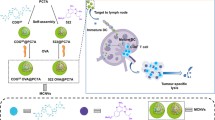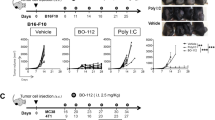Abstract
Innate adjuvant receptors are expressed in immune cells and some types of cancers. If antitumor therapies targeting these receptors are established, it is likely that they will be therapeutically beneficial because antitumor effects and immune-cell activation can be induced simultaneously. In this study, we tested this possibility of using an innate adjuvant receptor ligand, polyinosinic–polycytidylic acid [poly(I:C)], to treat human breast cancer cell lines. Three breast cancer cell lines (MCF-7, MDA-MB-231, and BT-549) were used in this study. Poly(I:C) was transfected into these cancer cells to stimulate melanoma differentiation–associated gene (MDA) 5, which is a cytoplasmic adjuvant receptor. Poly(I:C) transfection significantly reduced the viability of all cell lines in a manner partially dependent on MDA5. Flow cytometeric analyses and immunoblot assays revealed that the antitumor effect depended on both caspase-dependent apoptosis and c-Myc- and cyclinD1-dependent growth arrest. Interestingly, poly(I:C) transfection was accompanied by autophagy, which is thought to protect cancer cells from apoptosis after poly(I:C) transfection. In a xenograft mouse model, local transfection of poly(I:C) significantly inhibited the growth of xenografted MDA-MB-231 cells. Our findings indicate that cytoplasmic delivery of poly(I:C) can induce apoptosis and growth arrest of human breast cancer cells, and that therapy-associated autophagy prevents apoptosis. The results of this study suggest that the innate adjuvant receptors are promising targets and that their ligands could serve as antitumor reagents, which have the potential to simultaneously induce antitumor effects and activate immune cells.







Similar content being viewed by others
Abbreviations
- CFSE:
-
Carboxyfluorescein diacetate, succinimidyl ester
- DC:
-
Dendritic cell
- IFN:
-
Interferon
- MDA:
-
Melanoma differentiation–associated gene
- PI:
-
Propidium iodide
- poly(I:C):
-
Polyinosinic–polycytidylic acid
- siRNA:
-
Small interfering RNA
- TLR:
-
Toll-like receptor
- WST-8:
-
2-(2-Methoxy-4-nitrophenyl)-3-(4-nitrophenyl)-5-(2, 4-disulfophenyl)-2H-tetrazolium monosodium salt
References
Takeda K, Kaisho T, Akira S (2003) Toll-like receptors. Ann Rev Immunol 21:335–376
Apetoh L, Ghiringhelli F, Tesniere A et al (2007) Toll-like receptor 4-dependent contribution of the immune system to anticancer chemotherapy and radiotherapy. Nat Med 13:1050–1059
Curtin JF, Liu N, Candolfi M et al (2009) HMGB1 mediates endogenous TLR2 activation and brain tumor regression. PLoS Med 13:6:e10
Park SG, Jiang Z, Mortenson ED et al (2010) The therapeutic effect of anti-HER2/neu antibody depends on both innate and adaptive immunity. Cancer Cell 18:160–170
Bumette BC, Liang H, Lee Y et al (2011) The efficacy of radiotherapy relies upon induction of type I interferon-dependent innate and adaptive immunity. Cancer Res 71:2488–2496
Stagg J, Loi S, Divisekara U et al (2011) Anti-ErbB-2 mAb therapy requires type I and II interferins and synergizes with anti-PD-1 or anti-CD137 mAb therapy. Proc Natl Acad Sci USA 108:7142–7147
Kelly MG, Alvero AB, Chen R et al (2006) TLR-4 signaling promotes tumor growth and paclitaxel chemoresistance in ovarian cancer. Cancer Res 66:3859–3868
Szczepanski MJ, Czystowska M, Szajnik M et al (2009) Triggering of toll-like receptor 4 expressed on human head and squamous cell carcinoma promotes tumor development and protects the tumor from immune attack. Cancer Res 69:3105–3113
He W, Liu Q, Wang L, Chen W, Li N, Cao X (2007) TLR4 signaling promotes immune escapes of human lung cancer cells by inducing immunosuppressive cytokines and apoptosis resistance. Mol Immunol 44:2850–2859
Chiron D, Pellat-Deceunynck C, Maillasson M, Bataille R, Jego G (2009) Phosphorothioate-modified TLR9 ligands protect cancer cells against TRAIL-induced apoptosis. J Immunol 183:4371–4377
Cai Z, Sanchez A, Shi Z, Zhang T, Liu M, Zhang D (2011) Activation of toll-like receptor 5 on breast cancer cells by flagellin suppresses cell proliferation and tumor growth. Cancer Res 71:2466–2475
Morikawa T, Sugiyama A, Kume H et al (2007) Identification of toll-like receptor 3 as a potential therapeutic target in clear renal cell carcinoma. Clin Cancer Res 13:7503–7509
Salaun B, Lebecque S, Matikainen S, Rimoldi D, Romero P (2007) Toll-like receptor 3 expressed by melanoma cells as a target for therapy? Clin Cancer Res 13:4565–4574
Salaun B, Coste I, Rissoan MC, Lebecque SJ, Renno T (2006) TLR3 can directly trigger apoptosis in human cancer cells. J Immunol 176:4894–4901
Salaun B, Zitvogel L, Asselin-Paturel C et al (2011) TLR3 as a biomarker for the therapeutic efficacy of double-stranded RNA in breast cancer. Cancer Res 71:1607–1614
Matsumoto M, Seya T (2008) TLR3: interferon induction by double-strand RNA including poly(I:C). Adv Drug Delivery Rev 60:805–812
Kato H, Takeuchi O, Sato S et al (2006) Differential roles of MDA5 and RIG-I helicases in the recognition of RNA viruses. Nature 441:101–105
Tormo D, Checinska A, Alonso-Curbelo D et al (2009) Targeted activation of innate immunity for therapeutic induction of autophagy and apoptosis in melanoma cells. Cancer Cell 16:103–114
Besch R, Poeck H, Hohenauer T et al (2009) Proapoptotic signaling induced by RIG-I and MDA-5 results in type I interferon-independent apoptosis in human melanoma cells. J Clin Invest 119:2399–2411
Gewirtz DA (2009) Autophagy, senescence and tumor dormancy in cancer therapy. Autophagy 5:1232–1234
Buckley CD, Pilling D, Henriquez NV et al (1999) RGD peptides induce apoptosis by direct caspase-3 activation. Nature 397:534–539
Levine B, Kroemer G (2008) Autophagy in the pathogenesis of diseases. Cell 132:27–42
Kabeya Y, Mizushima N, Ueno T et al (2000) LC3, a mammalian homologue of yeast Apg8p, is localized in autophagosome membranes after processing. EMBO J 19:5720–5728
Liang XH, Jackson S, Seaman M, Brown K, Kempkes B, Hibshoosh H, Levine B (1999) Induction of autophagy and inhibition of tumorigenesis by beclin 1. Nature 402:672–676
Ghiringhelli F, Apetoh L, Housseau F, Kroemer G, Zitvogel L (2007) Links between innate and cognate tumor immunity. Curr Opin Immunol 19:224–231
Ullrich E, Menard C, Flament C et al (2008) Dendritic cells and innate defense against tumor cells. Cytokine Growth Factor Rev 19:79–92
Barchet W, Wimmenauer V, Schlee M, Hartman G (2008) Accessing the therapeutic potential of immunostimulatory nucleic acids. Curr Opin Immunol 20:389–395
Ebihara T, Azuma M, Oshiumi H et al (2010) Identification of polyI:C-inducible membrane protein that participates in dendritic cell-mediated natural killer cell activation. J Exp Med 207:2675–2687
Hirabayashi K, Yano J, Inoue T et al (1999) Inhibition of cancer cell growth by polyinosinic–polycytidylic acid/cationic liposome complex: a new biological activity. Cancer Res 59:4325–4333
Peng S, Geng J, Sun R, Tian Z, Wei H (2009) Polyinosinic–polycytidylic acid liposome induces human hepatoma cells apoptosis which correlates to the up-regulation of RIG-I like receptors. Cancer Sci 100:529–536
Harashima N, Inao T, Imamura R, Okano S, Suda T, Harada M (2012) Roles of the PI3K/Akt pathway and autophagy in TLR3 signaling-induced apoptosis and growth arrest of human prostate cancer cells. Cancer Immunol Immunother (in press)
Muise-Hemericks RC, Grimes H, Bellacosa A, Malstrom SE, Tsichlis PN, Rosen N (1998) Cyclin D expression is controlled post-transcriptionally via a phosphatidylinositol 3-kinase/Ae-dependent pathway. J Biol Chem 273:29864–29872
Akar U, Chaves-Reyz A, Barrio M et al (2008) Silencing Bcl-2 expression by small interfering RNA induces autophagic cell death in MCF-7 breast cancer cells. Autophagy 4:669–679
Mujumdar N, Mackenzie TN, Dudeja V et al (2010) Triptolide induces cell death in pancreatic cancer cells by apoptotic and autophagic pathways. Gastroenterology 139:598–608
Bonapace L, Bornhauser BC, Schmitz M et al (2010) Induction of autophagy-dependent necrosis is required for childhood acute lymphoblastic leukemia cells to overcome glucocorticoid resistance. J Clin Invest 120:1310–1323
Dalby KN, Takedareli I, Lopez-Berestein G, Ozpolat B (2010) Targeting the prodeath and prosurvival functions of autophagy as novel therapeutic strategies in cancer. Autophagy 6:322–329
Hou W, Han J, Lu C, Goldstein LA, Rabinowich H (2010) Autophagic degradation of active caspase-8. A crosstalk mechanism between autophagy and apoptosis. Autophagy 6:891–900
Yang Y, Xing D, Zhou F, Chen Q (2010) Mitochondrial autophagy protects against heat shock-induced apoptosis through reducing cytosolic cytochrome c release and downstream caspase-3. Biochem Biophys Rres Commun 395:190–195
Acknowledgments
We thank Ms. Yasuko Moriyama for her technical assistance. This study was supported in part by grants from the Ministry of Education, Culture, Sports, Science and Technology, Japan (no. 18591449 to M.H. and no. 23701074 to N.H.).
Conflict of interest
None.
Author information
Authors and Affiliations
Corresponding author
Electronic supplementary material
Below is the link to the electronic supplementary material.
Rights and permissions
About this article
Cite this article
Inao, T., Harashima, N., Monma, H. et al. Antitumor effects of cytoplasmic delivery of an innate adjuvant receptor ligand, poly(I:C), on human breast cancer. Breast Cancer Res Treat 134, 89–100 (2012). https://doi.org/10.1007/s10549-011-1930-3
Received:
Accepted:
Published:
Issue Date:
DOI: https://doi.org/10.1007/s10549-011-1930-3




